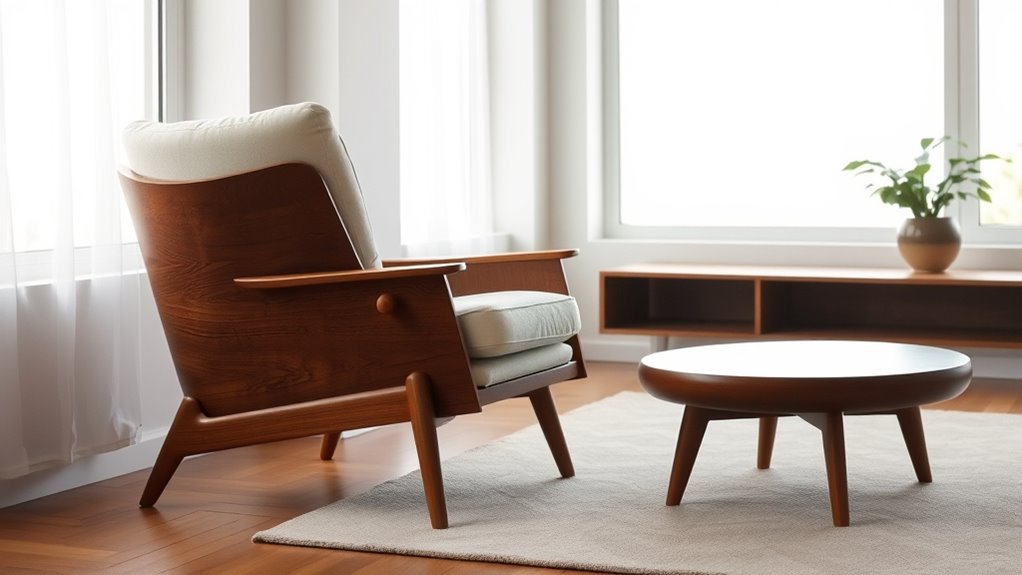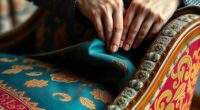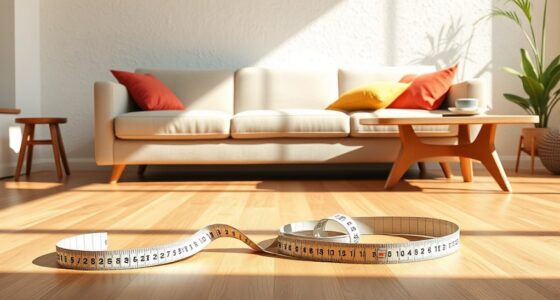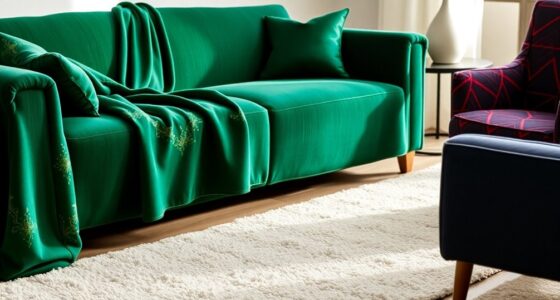To identify authentic mid-century modern furniture, look for sleek, clean lines, tapered or splayed legs, and minimalist hardware like brass pulls. Examine craftsmanship—tight joints, natural wood veneers, and smooth finishes are key signs. Pay attention to distinctive shapes, bold colors, and stylish supports that reflect the era’s focus on form and function. Noticing signature marks or labels from known designers can confirm authenticity—continue exploring for more expert tips.
Key Takeaways
- Look for sleek, minimalist hardware like brass or gold-toned pulls, often D-shaped or circular, characteristic of mid-century design.
- Identify distinctive tapered, splayed, or angled legs with metal accents or brackets for authentic styling.
- Examine construction joints such as dovetails and mortise-tenon for high craftsmanship and durability.
- Recognize natural wood finishes with visible grain, smooth surfaces, and veneer patterns typical of teak, walnut, or rosewood.
- Check for labels, maker marks, or signatures from iconic designers or brands to verify authenticity.
Recognizing the Signature Lines and Silhouettes
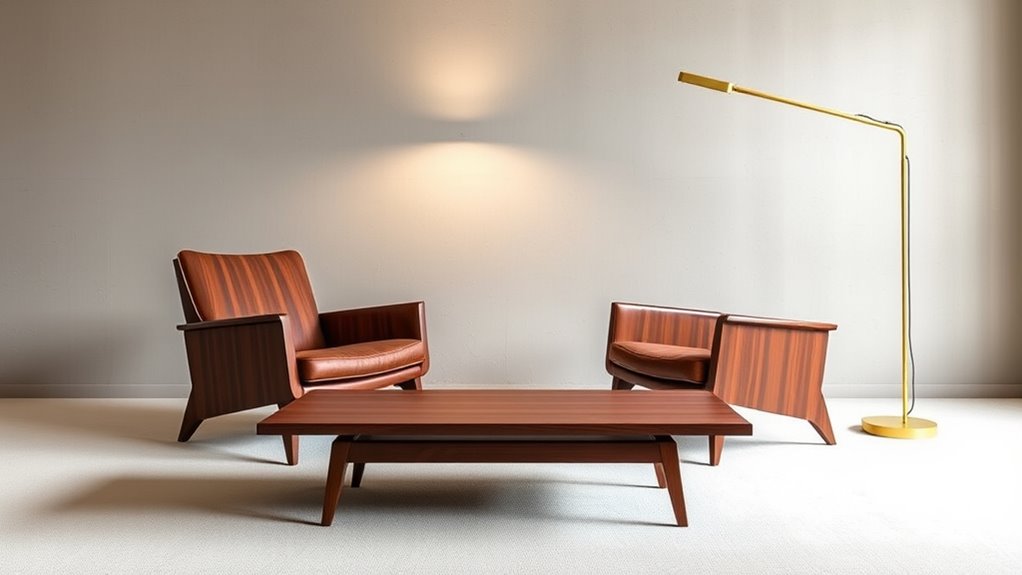
To recognize Mid-Century Modern furniture, focus on its distinctive lines and silhouettes, which set it apart from other styles. You’ll notice clean, geometric shapes with smooth, flowing curves that emphasize simplicity and functionality. Many pieces feature a low profile, with tapered legs that elevate the furniture off the ground, creating an airy feel. Vintage fabric is often used in upholstery, showcasing bold patterns or solid colors that add character. Brass accents are common, providing a touch of warmth and sophistication without overwhelming the design. These elements combine to create furniture that looks streamlined and timeless, emphasizing form as much as function. Paying attention to signature design elements will help you easily identify authentic Mid-Century Modern pieces.
Examining Material Choices and Finishes
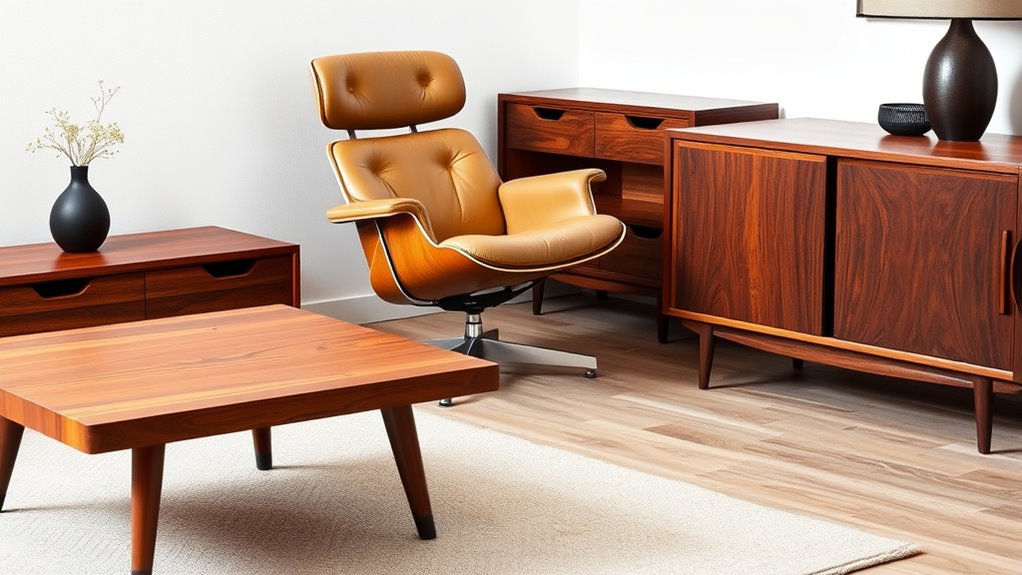
Mid-Century Modern furniture not only stands out through its sleek lines and shapes but also through its thoughtful selection of materials and finishes. You’ll notice the emphasis on showcasing natural beauty through wood grain, which adds warmth and texture to pieces. Veneer patterns often play a key role, creating eye-catching visuals that highlight the craftsmanship. Look closely at the surface: smooth finishes and subtle sheen are common, revealing the quality of the materials used. Finishes like teak oil or lacquer enhance the wood’s natural look and durability. The choice of veneer and finish isn’t just aesthetic; it also reflects the era’s focus on functional beauty and innovative design. Understanding these material details helps you recognize authentic Mid-Century Modern furniture with confidence, especially by observing the material selection and craftsmanship techniques characteristic of the period.
Identifying Characteristic Legs and Supports
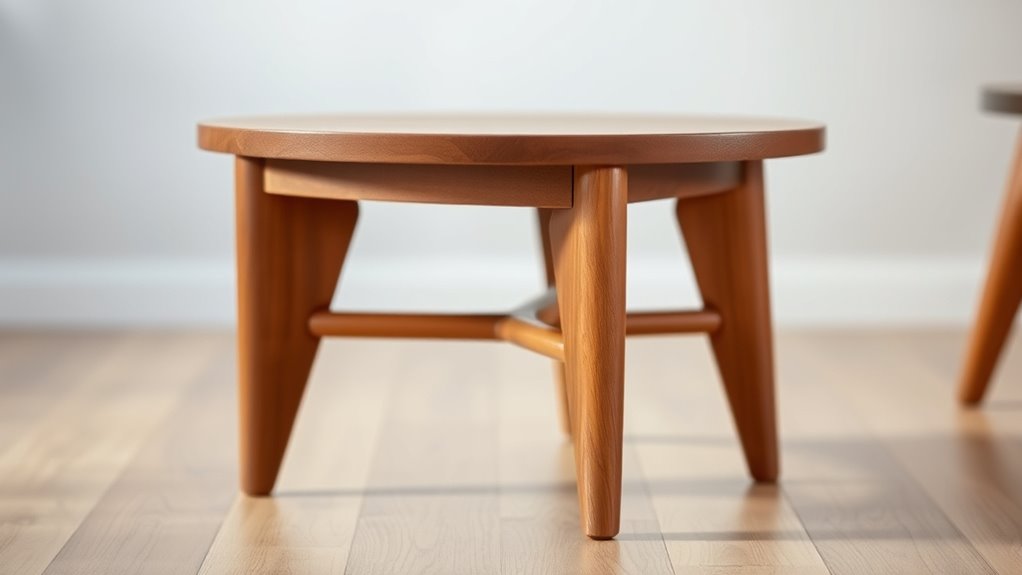
You’ll notice that mid-century modern furniture often features tapered legs that narrow toward the floor, giving pieces a sleek look. Curved support structures add both stability and a distinctive style that sets this era apart. Pay attention to the materials and finishes used on the legs and supports, as they often highlight the craftsmanship and design trends of the period. Additionally, the use of bold geometric shapes is a hallmark characteristic that further distinguishes mid-century modern furniture from other styles.
Tapered Leg Shapes
Tapered legs are a defining feature of mid-century modern furniture, giving pieces a sleek and elegant appearance. You can identify these by examining the tapered leg shapes, which gradually narrow from the top to the bottom. The leg tapering techniques used in this style often involve precise cuts and smooth progressions, highlighting craftsmanship. These legs typically start wider at the top and subtly narrow toward the floor, creating a sense of lightness and space. Look for tapered legs made of wood with clean lines and minimal ornamentation, as these are hallmarks of mid-century design. The tapering process emphasizes simplicity while adding visual interest, making furniture not only functional but also aesthetically appealing. Recognizing these features helps you confidently identify authentic mid-century modern pieces, especially when considering craftsmanship and attention to detail.
Curved Support Structures
Have you noticed the elegant curves that support mid-century modern furniture? These curved support structures often feature sculptural forms and fluid lines, giving pieces a distinctive, artistic look. They’re not just functional—they add visual interest and a sense of movement. To identify these supports, look for:
- Gentle, sweeping curves that resemble organic shapes
- Supports that appear as sculptural forms rather than simple legs
- Fluid lines that connect seamlessly to the furniture’s main structure
- Curved braces or uprights that contribute to the overall aesthetic
- Linguistic features and design elements that reflect the era’s emphasis on form and function
These elements highlight the craftsmanship and design philosophy of mid-century modern pieces, emphasizing form and function. Recognizing these curved supports helps you distinguish authentic vintage furniture from reproductions.
Material and Finish Styles
Recognizing the material and finish styles of mid-century modern furniture helps you identify authentic pieces and appreciate their design. Look closely at the wood grain; it’s often smooth with visible, natural patterns that highlight the craftsmanship. Legs and supports frequently feature sleek, tapered profiles, emphasizing clean lines and minimalism. Metal accents are common, adding a touch of contrast and modernity—think slim, polished metal legs or supports that complement wooden elements. Finishes tend to be natural or lightly stained, showcasing the wood’s grain and warmth. Sometimes, you’ll see painted or lacquered surfaces, but the focus remains on the harmony between materials. By observing these details, you can distinguish genuine mid-century modern furniture and understand its emphasis on simplicity, functionality, and high-quality craftsmanship. Additionally, paying attention to material and finish styles can reveal the era’s commitment to blending form and function seamlessly.
Spotting Typical Color Palettes and Upholstery

Mid-century modern furniture is renowned for its distinctive color palettes and upholstery choices that reflect the era’s emphasis on simplicity and functionality. When spotting authentic pieces, look for vintage color palettes featuring warm oranges, mustard yellows, olive greens, and muted browns. These hues were popular during the mid-20th century and often appear in furniture upholstery. Additionally, some pieces incorporate gears and mechanical elements, subtly hinting at the industrial influences that also shaped the design aesthetics of the time.
Keep an eye out for these upholstery fabric choices:
- Textured wool blends
- Smooth vinyl or leather
- Bold geometric patterns
- Solid, muted tones
Understanding Iconic Hardware and Details
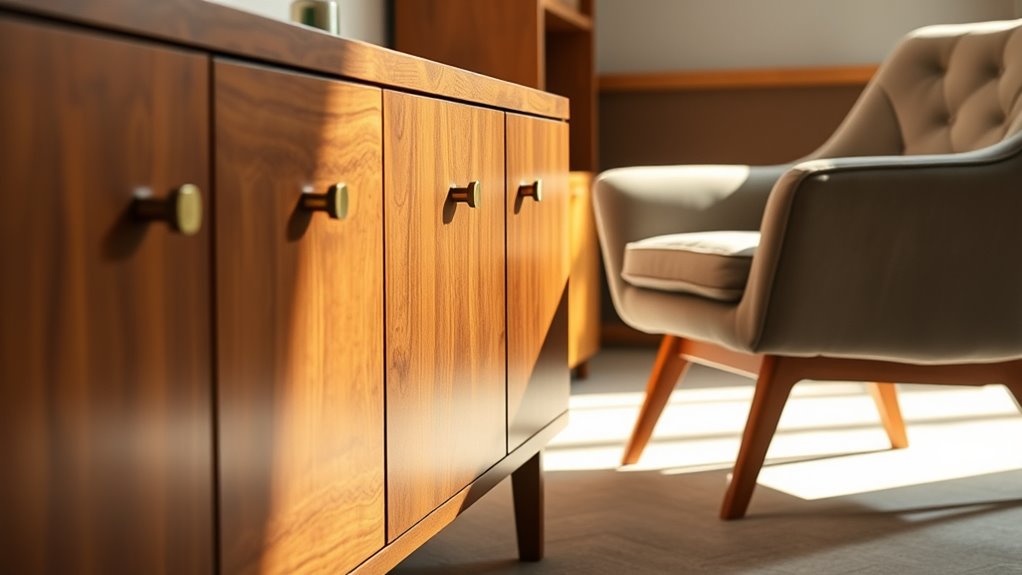
You’ll want to pay attention to the hardware that defines mid-century modern pieces, like the sleek pulls that add a touch of elegance. Recognizing the distinctive legs, whether tapered or splayed, helps you identify authentic designs. These details make a big difference in capturing the true spirit of the era. Additionally, understanding the design principles behind mid-century furniture can aid in distinguishing genuine pieces from reproductions.
Recognizing Unique Pulls
Iconic hardware is one of the easiest ways to identify mid-century modern furniture, as distinctive pulls and handles often reflect the era’s design ethos. These unique drawer pulls and cabinet handles often feature sleek lines, geometric shapes, or organic curves that stand out. Recognizing these details can instantly confirm the piece’s vintage.
Here are 4 signs to look for:
- Brass or gold-toned pulls with minimalist shapes.
- D-shaped or circular handles that are simple yet stylish.
- Integrated pulls that are part of the drawer or door design.
- Bold, geometric patterns that emphasize form over ornamentation.
Focusing on these hardware cues helps you quickly identify authentic mid-century modern furniture.
Spotting Distinctive Legs
Distinctive legs are key indicators of mid-century modern furniture’s timeless appeal. Look closely at the legs’ shape, material, and placement to identify authentic pieces. Many feature tapered, angled, or splayed designs that add a sleek, minimalist look. These legs often come with vintage upholstery that complements the furniture’s clean lines. Pay attention to decorative hardware—such as metal accents or unique brackets—that often adorn the legs or frame, adding subtle character. Well-crafted legs can reveal the era’s emphasis on functionality combined with style. Authentic mid-century modern pieces rarely have bulky or ornate legs, so if you notice slender, streamlined supports, it’s a good sign. Recognizing these details helps distinguish genuine vintage furniture from reproductions. Durable wooden construction is another hallmark of quality mid-century modern pieces, ensuring longevity and style.
Analyzing Construction Techniques and Joints
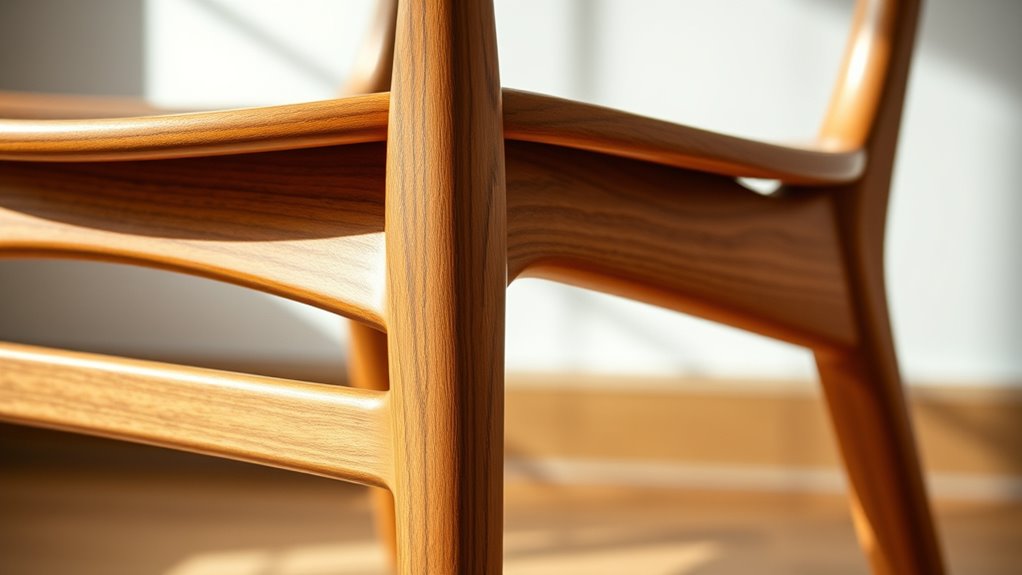
Have you ever wondered how mid-century modern furniture achieves its sleek, minimalist look while remaining sturdy? It all comes down to careful construction techniques and joint types. It is also important to observe the quality craftsmanship evident in the joints, which ensures durability and authentic design. You should look for signs of quality assembly methods, such as tight, seamless joints that indicate strong craftsmanship. Key points include:
- Dovetail joints—interlocking and durable, often used in drawers.
- Mortise and tenon joints—provide stability in table and chair frames.
- Butt joints reinforced with dowels or nails—common in less expensive pieces.
- Scarph joints—used for longer spans, ensuring strength without visible hardware.
Understanding these construction elements helps you identify authentic pieces that are built to last, with joints that reflect the craftsmanship typical of mid-century modern design.
Distinguishing Authentic Pieces From Reproductions
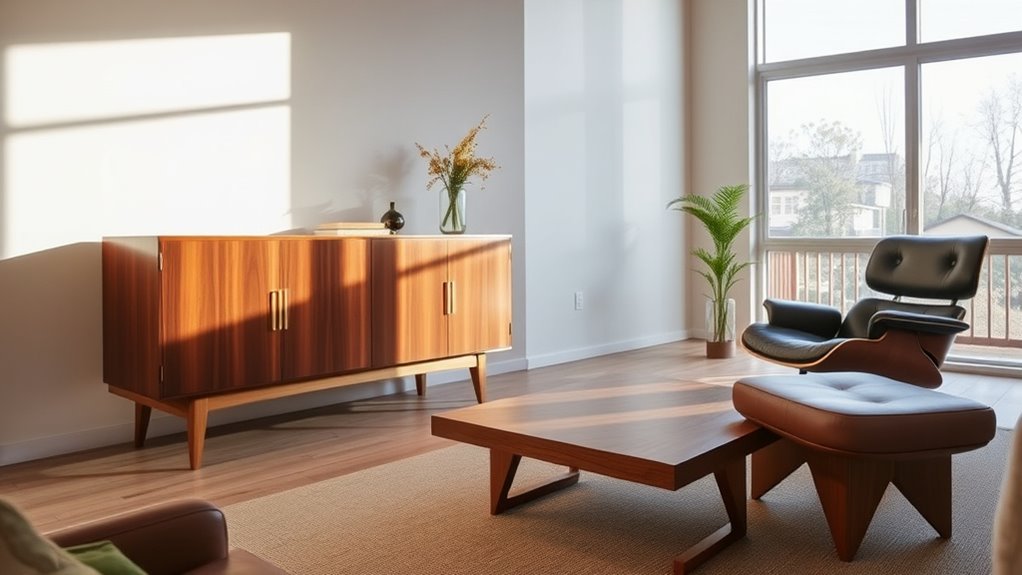
To accurately distinguish authentic mid-century modern furniture from reproductions, you need to pay close attention to specific details that reveal the piece’s true origin. In the vintage market, genuine pieces often display signs of age, like wear on joints or patina on wood, which reproductions lack. Reproduction trends tend to favor cheaper materials and modern manufacturing techniques, making them look less authentic. Check for labels, stamps, or maker marks, as original pieces frequently bear these identifiers. Examine craftsmanship closely—authentic furniture features precise joinery and high-quality finishes, while reproductions might have inconsistent details or glued joints. Becoming familiar with these subtle cues helps you identify true vintage pieces and avoid falling for trendy, mass-produced fakes.
Recognizing Popular Designers and Brands
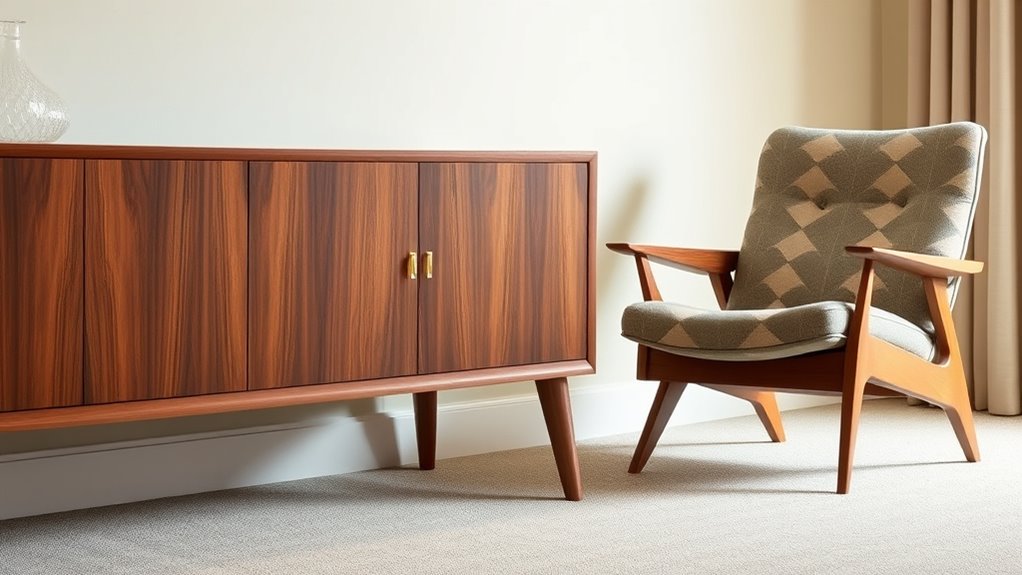
Recognizing popular designers and brands is essential for verifying the authenticity and value of mid-century modern furniture. By understanding vintage branding and designer signatures, you can distinguish genuine pieces from reproductions. Here are key tips:
- Look for signature marks or labels often stamped or engraved by the designer.
- Familiarize yourself with iconic brands like Eames, Saarinen, and Nelson.
- Check for consistent style elements linked to specific designers.
- Research vintage branding techniques used during the mid-century era.
Noticing these details helps confirm provenance and adds value to your collection. Recognizing the subtle cues in designer signatures and branding ensures you’re investing in authentic, timeless furniture pieces, making your collection both meaningful and valuable.
Tips for Authenticating Mid-Century Modern Furniture
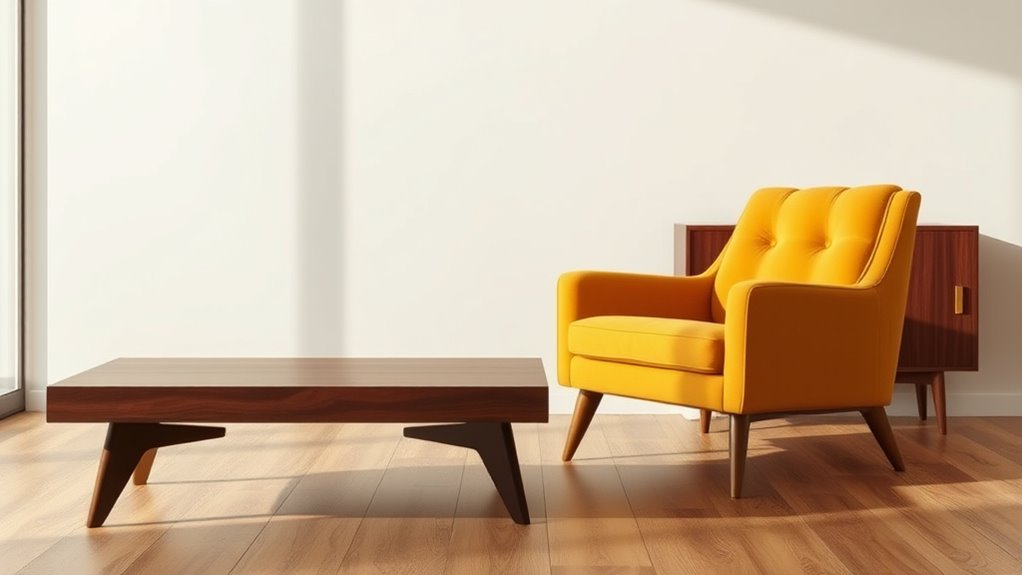
Authenticating mid-century modern furniture requires careful examination of several key details. Look for signs of vintage craftsmanship, such as joinery, wood grain, and construction methods that reflect the period’s unique style. Check for authentic marks or labels from reputable designers or manufacturers. Be wary of furniture that has been heavily restored; some restoration techniques can mask original features. To verify authenticity, compare the piece to known examples and inspect the finish, joints, and hardware.
| Feature | Authentic Indicator | Common Restoration Clues |
|---|---|---|
| Wood & Finish | Original veneer, aged patina | Refinished surface, uneven sheen |
| Joints & Construction | Dovetail joints, hand-cut details | Modern staples, machine-cut parts |
| Hardware | Original metal hardware or replicates | Replaced or mismatched hardware |
| Labels & Markings | Manufacturer labels, designer stamps | Faded, removed, or fake labels |
Frequently Asked Questions
How Can I Date a Piece of Mid-Century Modern Furniture Accurately?
To date a piece of mid-century modern furniture accurately, you should examine furniture marking techniques and vintage labeling standards. Look for labels, stamps, or engravings that indicate the manufacturer or date. Research these markings to identify the era they belong to. Pay attention to construction details, materials, and design features common at that time. Combining these clues helps you establish a reliable estimate of your furniture’s age.
What Are Common Signs of Restoration or Repairs in Authentic Pieces?
You look for signs like uneven or overly shiny surfaces, inconsistent patina development, and fresh-looking paint or varnish to spot restoration or repairs. These clues reveal modern refinishing, where the finish might appear too perfect or new. Check for mismatched wood grains, glued joints, or filled-in cracks. These signs help you distinguish authentic pieces from those that have been restored or repaired, ensuring your furniture’s history stays intact.
How Do I Differentiate Between Genuine Teak and Other Woods?
To differentiate genuine teak from other woods, look at the wood grain and color consistency. Teak has a straight, tight grain with a smooth texture, often showing natural oils that add a warm, golden-brown hue. If the color varies or the grain looks unnatural or inconsistent, it might be a different wood. Genuine teak ages gracefully, developing a silvery patina over time, unlike other woods that may fade or stain unevenly.
Are There Specific Tools or Methods for Identifying Vintage Hardware?
You can use vintage hardware tools like magnifying glasses or small pry tools to examine details closely, helping with hardware identification methods. Look for maker marks, stamps, or unique design features that indicate authenticity or age. Using a soft brush can help clean dirt to reveal markings. Comparing your hardware to online resources or consulting experts can further confirm its vintage status, ensuring you accurately identify genuine pieces.
What Should I Look for to Verify the Provenance of a Piece?
Think of provenance as a fingerprint for furniture; it reveals its true story. To verify it, look for furniture maker marks or signatures that confirm authenticity. Examine labels, stamps, or carved initials—these are clues to origin. Cross-reference these details with known archives or databases. Authentic signatures and consistent maker marks help establish provenance, ensuring your piece’s history is genuine and valuable.
Conclusion
By mastering these tips, you’ll become a detective in the world of mid-century modern furniture, spotting authentic treasures from clever fakes. Think of it as uncovering hidden gems in a vast treasure chest—each piece tells a story of design innovation and style. Trust your eye, stay curious, and soon you’ll confidently navigate the vintage furniture landscape like a true expert. Happy hunting!
